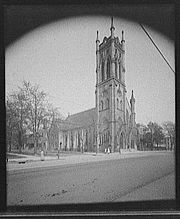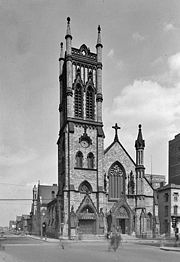.gif)
St. John's Episcopal Church (Detroit, Michigan)
Encyclopedia
St. John's Episcopal Church is located at 2326 Woodward Avenue in Detroit, Michigan
(at the corner of Woodward and the Fisher Freeway service drive). However, the business address is 50 E Fisher Fwy, Detroit, MI. It is the oldest church still standing on Woodward. The church was listed on the National Register of Historic Places
in 1982 and designated a Michigan State Historic Site in 1987.

 The parish of St. John's was organized in Detroit in 1858, primarily due to the efforts of Henry Porter Baldwin, a successful merchant (who later became governor of Michigan and a United States senator). Porter purchased and donated a lot on the northern outskirts of Detroit at the corner of Woodward and High Street (now I-75). Porter also donated money to build a rectory and a 150-seat chapel, designed by Jordan and Anderson.
The parish of St. John's was organized in Detroit in 1858, primarily due to the efforts of Henry Porter Baldwin, a successful merchant (who later became governor of Michigan and a United States senator). Porter purchased and donated a lot on the northern outskirts of Detroit at the corner of Woodward and High Street (now I-75). Porter also donated money to build a rectory and a 150-seat chapel, designed by Jordan and Anderson.
When the chapel was dedicated in 1859, it was already too small for the burgeoning congregation. A new Church was commissioned from Jordan and Anderson and quickly constructed; it was consecrated on December 10, 1861.
The church is unusual in using the traditional 1928 edition of the Book of Common Prayer
, in combination with the Anglican Missal
.
There are six memorial stained glass windows on either side of the nave. These were installed between 1880 to 1954. The upper portions of the windows, above the stained glass, are still the original grisaille
and colored glass. An additional window, above the west gallery, was dedicated in 1963.
The altar, installed in 1873, is constructed of white Caen stone
altar; it serves as a memorial to the mother of then-Rector George Worthington. Most of the rest of the chancel furnishings were donated as memorials during the renovations in 1892. These include the screen made from wrought iron and Caen stone, the harmonizing pulpit, and the brass lectern. Hand-carved oak clergy and choir stalls were added following the 1936 renovation.
There have been two major architectural alterations to St. John's since the church was built. The first, in 1892, deepened the chancel
to create space for the organ console and the choir. This alteration required that the original chapel be taken down and rebuilt ten feet farther east. In 1936, Woodward Avenue was widened. To make way for the wider street, the entire church and chapel were moved 60 feet backwards.
The oldest part of the church, the chapel, still stands, and includes a number of stained glass windows. A State of Michigan historical marker now marks the church.
Michigan
Michigan is a U.S. state located in the Great Lakes Region of the United States of America. The name Michigan is the French form of the Ojibwa word mishigamaa, meaning "large water" or "large lake"....
(at the corner of Woodward and the Fisher Freeway service drive). However, the business address is 50 E Fisher Fwy, Detroit, MI. It is the oldest church still standing on Woodward. The church was listed on the National Register of Historic Places
National Register of Historic Places
The National Register of Historic Places is the United States government's official list of districts, sites, buildings, structures, and objects deemed worthy of preservation...
in 1982 and designated a Michigan State Historic Site in 1987.
History


When the chapel was dedicated in 1859, it was already too small for the burgeoning congregation. A new Church was commissioned from Jordan and Anderson and quickly constructed; it was consecrated on December 10, 1861.
The church is unusual in using the traditional 1928 edition of the Book of Common Prayer
Book of Common Prayer
The Book of Common Prayer is the short title of a number of related prayer books used in the Anglican Communion, as well as by the Continuing Anglican, "Anglican realignment" and other Anglican churches. The original book, published in 1549 , in the reign of Edward VI, was a product of the English...
, in combination with the Anglican Missal
Anglican Missal
The Anglican Missal is a liturgical book often used at Mass by Anglo-Catholics and other High Church Anglicans instead of the Book of Common Prayer.-History:...
.
Architecture
St. John's is an excellent example of Victorian Gothic architecture, measuring 170 feet by 65 feet. The belfry, the tallest section of the building, rises 105 feet. The bulk of the exterior is rubble limestone, with the trim made of Kelly Island sandstone. The side walls and roof are supported by buttresses and hammer beam trusses. Decorative gargoyles festoon the roof line and hood moldings above the windows and doors. The interior has galleries cantilevered on three sides; originally there were no intermediary piers to support the roof, giving the church an auditorium feel.There are six memorial stained glass windows on either side of the nave. These were installed between 1880 to 1954. The upper portions of the windows, above the stained glass, are still the original grisaille
Grisaille
Grisaille is a term for painting executed entirely in monochrome or near-monochrome, usually in shades of grey. It is particularly used in large decorative schemes in imitation of sculpture. Many grisailles in fact include a slightly wider colour range, like the Andrea del Sarto fresco...
and colored glass. An additional window, above the west gallery, was dedicated in 1963.
The altar, installed in 1873, is constructed of white Caen stone
Caen stone
Caen stone or Pierre de Caen, is a light creamy-yellow Jurassic limestone quarried in northwestern France near the city of Caen.The limestone is a fine grained oolitic limestone formed in shallow water lagoons in the Bathonian Age about 167 million years ago...
altar; it serves as a memorial to the mother of then-Rector George Worthington. Most of the rest of the chancel furnishings were donated as memorials during the renovations in 1892. These include the screen made from wrought iron and Caen stone, the harmonizing pulpit, and the brass lectern. Hand-carved oak clergy and choir stalls were added following the 1936 renovation.
There have been two major architectural alterations to St. John's since the church was built. The first, in 1892, deepened the chancel
Chancel
In church architecture, the chancel is the space around the altar in the sanctuary at the liturgical east end of a traditional Christian church building...
to create space for the organ console and the choir. This alteration required that the original chapel be taken down and rebuilt ten feet farther east. In 1936, Woodward Avenue was widened. To make way for the wider street, the entire church and chapel were moved 60 feet backwards.
The oldest part of the church, the chapel, still stands, and includes a number of stained glass windows. A State of Michigan historical marker now marks the church.
External links
- St. John's Episcopal Church
- St. John's from Detroit1701.org

